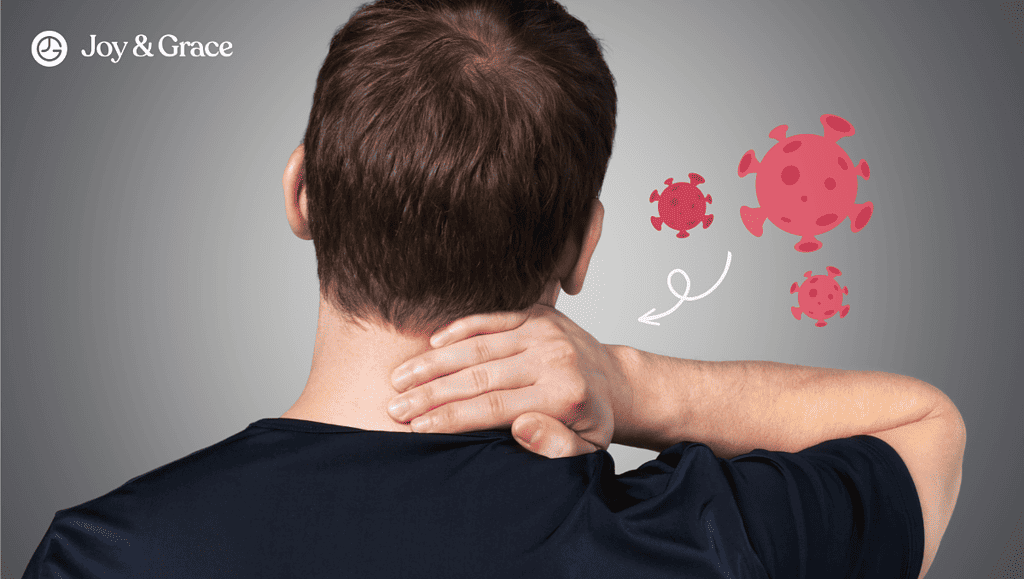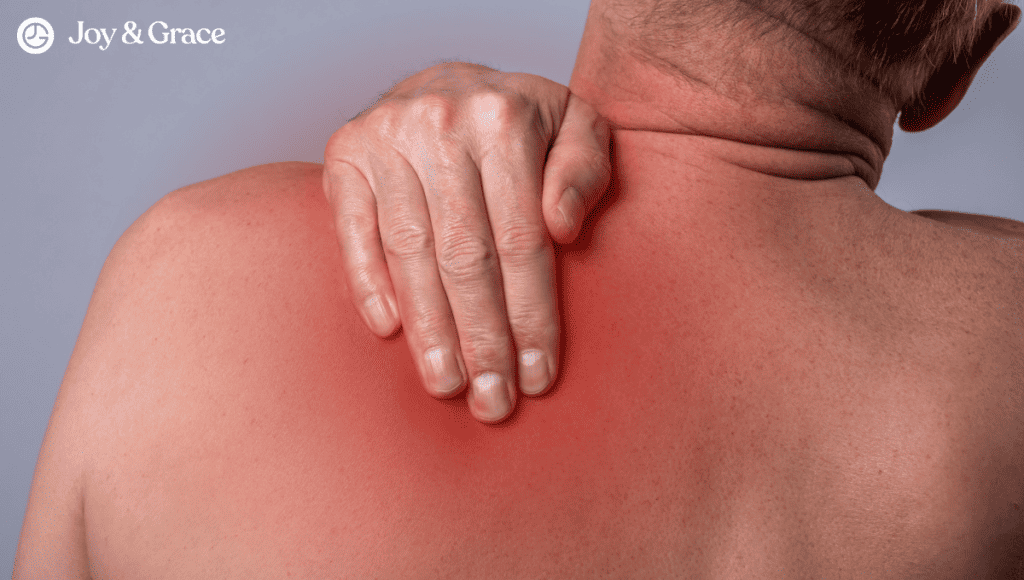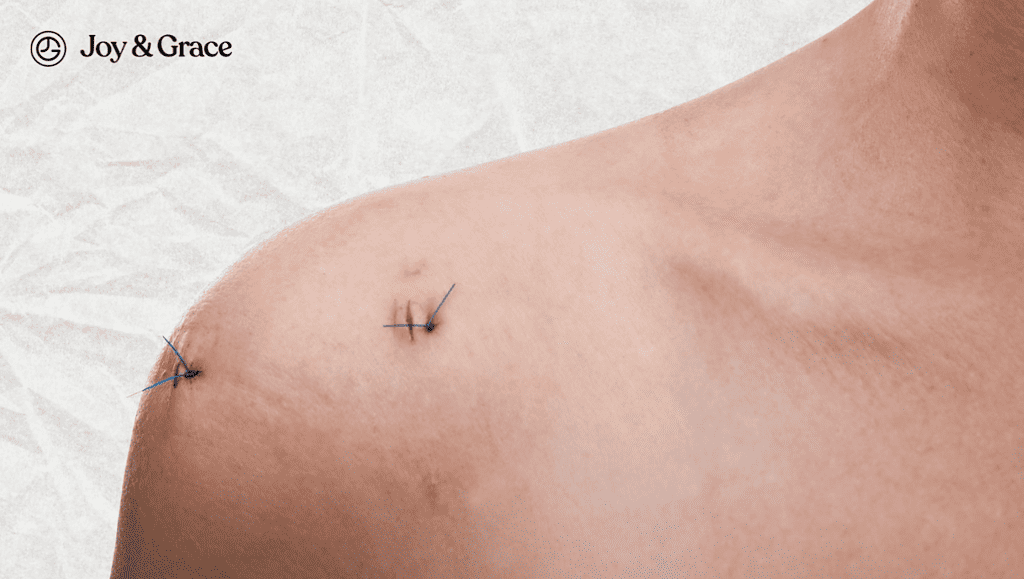Putting on or taking off a shirt is usually a relatively easy task that you take for granted. And this is all thanks to our shoulders and their wide range of motion. If you experience shoulder pain when taking off a shirt, it could be a sign of rotator cuff injury.
The Joy & Grace team has scoured articles and journals about rotator cuff injuries and how they could make taking off your shirts painful.
Why Does My Shoulder Hurt When I Take My Shirt Off?
Taking off a shirt should be a piece of cake when your shoulders are free from injury. But when the joint and other tissues of the shoulder become damaged, this is when things get painful. There are many reasons why taking a shirt off becomes a struggle, and these include the following:
- Shoulder Arthritis. Arthritis is the inflammation of the cartilage that makes up your joints. Over time, this inflammation causes the “ball and socket” joint of your shoulder to break down, resulting in shoulder pain.
- Adhesive Capsulitis. This is commonly known as a “frozen shoulder.” This occurs when your shoulder's connective tissue, called the capsule, is inflamed and becomes thick and stiff.
However, the most common cause of shoulder pain is a rotator cuff injury. Rotator cuff injuries can either be due to a rotator cuff tear or rotator cuff tendinitis, also known as shoulder impingement.
What Is A Rotator Cuff Tear?
The rotator cuff is a group of muscles and tendons that keep the shoulder joint together. These tissues play a vital role in keeping your shoulder stable and allowing you to raise and rotate your arm.
Constantly performing repetitive movements or overusing your shoulders may cause a rotator cuff tear and cause pain. An injury or persistent tendinitis may also cause tears in your rotator cuff. This is usually caused by the following:
- A fall.
- A direct hit to the shoulder.
- A rapid, jerking motion (such as pulling on a starter cable).
What Are The Types Of Rotator Cuff Tears?
The type of rotator cuff tear depends on whether the tendon separates from the bone. Rotator cuff tears can be divided into:
- Partial Tears. In this type of tear, the damage only goes through a portion of the tendon, causing it to thin out but not detach from the bone.
- Full-Thickness Tear. In this type of tear, the damage goes through the entire thickness of the tendon, causing detachment from the bone. It can be further divided into:
- Full-Thickness Incomplete Tear. This is when only a small part of the tendon detaches from the bone.
- Full-Thickness Complete Tear. The entire tendon is completely detached from the bone, leaving a gap that separates the tendon and bone.
- Full-Thickness Incomplete Tear. This is when only a small part of the tendon detaches from the bone.
How Common Are Rotator Cuff Tears?
According to the American Academy of Orthopedic Surgeons, rotator cuff tears commonly cause shoulder pain and disability in American Adults. An estimated 2 million Americans seek medical consultation yearly due to rotator cuff tears.
What Does Shoulder Pain From A Rotator Cuff Tear Feel Like?
A rotator cuff tear can cause a lot of different symptoms. You may feel:
- Pain when you lift or lower your arm, or when you do specific movements like taking off a shirt or reaching behind your back.
- Your arms may feel weak.
- The pain may be worse at night or when you're resting. This is especially true when you lie on the affected shoulder.
- You might also hear a cracking sound when you move your shoulders. This is called crepitus.
If your rotator cuff tear happened suddenly, like from a fall, you'll likely feel intense, sharp pain. You may also feel a snapping sensation and weakness in your arm.
Meanwhile, if your tear is from overuse or wear and tear, it may develop more slowly. It tends to start off mild, but it gets worse over time. At first, you may only notice it when you raise your arms, like when you reach overhead. Painkillers can help, but as the pain gets worse, they may not work anymore.
It's important to remember that the amount of pain you feel doesn't always match up with how severe your tear is. You could have a partial tear and feel a lot of pain, or a full tear and not feel any pain at all.
How Do You Self Check For A Rotator Cuff Tear?
Although it is always better to seek medical consultation regarding severe injuries, there are ways to check if you have a torn rotator cuff. You may need someone to help you when doing these tests, though.
- Drop Arm Sign
- This test can help you tell if there is weakness in the supraspinatus muscle, which is part of the rotator cuff. The supraspinatus muscle is the most commonly torn out of all the rotator cuff muscles.
Here’s how you do it:
1. You may start in a standing or sitting position.
2. If you are able to, fully extend the injured arm straight to the side, away from your body. You can ask your helper to raise the injured arm if you cannot.
3. Try to lower the arm down slowly to your side, keeping it extended. It is important to lower the arm in a slow and controlled manner.
4. If you have a rotator cuff tear, it will be very painful to lower your arm. Sometimes you won’t be able to control your arm, and it will instantly flop to your side.
- This test can help you tell if there is weakness in the supraspinatus muscle, which is part of the rotator cuff. The supraspinatus muscle is the most commonly torn out of all the rotator cuff muscles.
- Lateral Jobe Test or Empty Can Test
- This is considered to be one of the most reliable tests for detecting rotator cuff tears. It is similar to the drop arm sign as it also looks for weakness in the supraspinatus muscle.
Here’s how to perform the lateral jobe test:
1. Fully extend the injured arm straight to the side, parallel to the ground.
2. Rotate the arm so your palm faces backward and your thumb faces down.
3. Ask somebody to apply downward force while you attempt to resist it.
4. If you experience pain while resisting the downward pressure, then it may be a sign of a rotator cuff tear.
- This is considered to be one of the most reliable tests for detecting rotator cuff tears. It is similar to the drop arm sign as it also looks for weakness in the supraspinatus muscle.
- Lift Off Test
- This test will assess the rotator cuff muscle in front of your shoulder, called the subscapularis muscle.
Here’s how to do it:
1. Place the injured arm behind your back, with the back of your hand resting on top of your lower back.
2. Try to raise your hand away from your back.
3. Pain or weakness when attempting to raise your hand can be a sign of a rotator cuff tear.
- This test will assess the rotator cuff muscle in front of your shoulder, called the subscapularis muscle.
What Are The Symptoms of Shoulder Impingement Syndrome?

Shoulder impingement syndrome is a condition that is commonly associated with rotator cuff tendinitis and bursitis. This is because these conditions occur after a specific sequence of events in your shoulder.
First, the head of your humerus (the bone of your upper arm) migrates within the socket of your shoulder. Once this happens, the tendons of your rotator cuff are “pinched” (this is where shoulder impingement comes from).
If this occurs repeatedly, the tendons eventually become irritated and swollen due to inflammation. This is now called rotator cuff tendinitis.
The fluid-filled sac around the rotator cuff, called the “bursa,” may also become inflamed and irritated (this is where bursitis comes from). Tendinitis and bursitis may also cause further pinching of the tendons.
Symptoms of shoulder impingement develop slowly and include:
- Shoulder pain when you extend your arms above your head
- Pain when lifting or lowering your arm
- Pain when passing an arm through the sleeve of your shirt
- Pain and tenderness in the front of your shoulder
- Pain that travels from the shoulder to the side of your arm
- Pain at night, especially when lying on the affected shoulder
- Pain when reaching behind your back, such as when attempting to zip or unzip a top or dress.
- Weakness and stiffness of the shoulder.
Does Shoulder Impingement Hurt All The Time?
Similar to rotator cuff tears, pain from shoulder impingement may only be noticeable when you are lifting objects or reaching. However, if left untreated and as the inflammation persists, you may start to feel shoulder pain all the time, even at rest.
What Is The Difference Between A Torn Rotator Cuff And Impingement?
It may be hard to differentiate a torn rotator cuff from shoulder impingement since both have similar symptoms. However, shoulder impingement tends to happen slowly after a period of months or even years of overuse. Meanwhile, rotator cuff tears usually occur after an injury or accident.
Furthermore, shoulder impingement results only from compression of the tissues of your shoulder. In comparison, rotator cuff tears are due to torn muscle fibers.
While the two have some differences, one can actually cause the other since they affect similar tissues. For example, a small rotator cuff tear may cause tendon swelling and impingement. Persistent tendon impingement may cause muscles of your rotator cuff to weaken, resulting in a rotator cuff tear.
What Can Help With Shoulder Pain From A Rotator Cuff Injury?
In severe cases of rotator cuff injuries, surgical treatment is usually required. However, milder cases may be managed by conservative methods such as:
- Rest. You should avoid any strenuous activity or movement that may make your rotator cuff injury even worse. Rest is also essential to help your injury heal faster.
- Immobilization. You may need to wear a sling to help keep your shoulder still and protect it from further injury. This also allows the injury to heal faster.
- Non-steroidal anti-inflammatory drugs. These include medications like ibuprofen and naproxen. These medications help reduce the swelling and pain from inflammation.
- Physical Therapy. A physical therapist may assist you in various exercises and stretches to strengthen your shoulder muscles. This also helps increase your flexibility and range of motion. Your therapist may also create a workout program that can help relieve pain and prevent further injury.
- Steroid Injections. Steroid injections may provide immediate relief from shoulder pain, especially when sleeping. Aside from relieving pain, these drugs are anti-inflammatory and may reduce swelling. You may also receive a nerve block for your shoulder pain.
If your pain persists despite these methods, it’s best to seek further medical evaluation.
How Long Does It Take For A Torn Rotator Cuff To Heal Without Surgery?

Although surgery is reserved for more severe cases, early treatment of any rotator cuff tear is essential. If treatment is delayed, the damaged tendon may shrink towards its other end, making healing more difficult. It may also make surgical repairs less effective.
Mild rotator cuff tears usually take up to four weeks to heal. Severe cases may take 4 to 6 months or longer, depending on certain factors. People can resume normal activities after six months. But they still need to be careful as a rotator cuff tear may take up to a year to heal completely.
The following factors can affect the healing of a rotator cuff tear:
- The severity of the tear
- Age
- Other health conditions.
How Long Does A Shoulder Impingement Take To Heal?
Shoulder impingement usually completely heals within three to six months. However, it may take up to a year for severe cases to heal. During your recovery, always make sure to check with your doctor regularly.
You may resume doing your daily activities within two to four weeks. Just make sure not to overwork your shoulder. If not, you may prolong your recovery or cause more injury.
What Should You Not Do With A Rotator Cuff Injury?
Avoid any activity involving raising your arms when recovering from shoulder impingement. These include throwing or sports such as tennis, baseball, and badminton. You should also take a break from weightlifting or swimming to allow your shoulder to heal.
Takeaway
Taking off a shirt may become painful for a variety of reasons. Sometimes, it may be due to a rotator cuff injury. Rotator cuff injuries occur from overuse of your shoulder muscles or an accident.
Rotator cuff injuries can be rotator cuff tears or shoulder impingement. While mild cases can be relieved by conservative treatments, it is still best to seek medical consultation to receive early treatment and prevent further injury.
If you found this article helpful, sign up for our newsletter to receive updates on our future posts!















